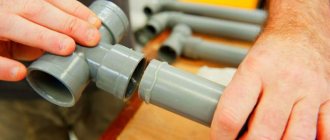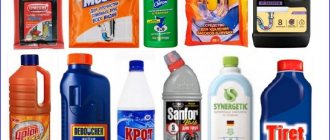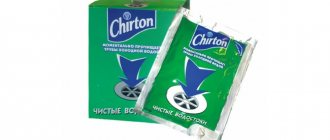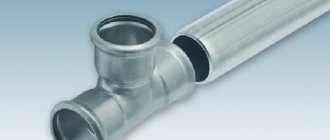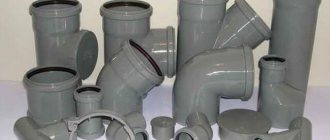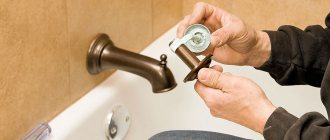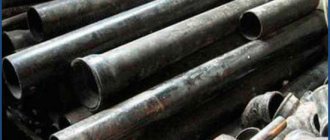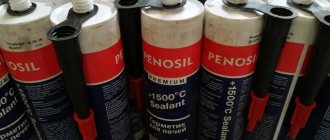One-component room temperature vulcanizing silicone sealants are easy to use, reliable and durable, making them very popular for various repair work.
In their initial state, silicone sealing materials have the form of a paste that can be applied to both horizontal and vertical surfaces. Contacting moisture from the air, the paste polymerizes and turns into durable silicone rubber.
Silicone-based sealants can be acidic or neutral. The former contain acetic acid, which helps the composition to better adhere to the surface and harden. Acidic sealants are less expensive than neutral sealants, but they should not be used on surfaces that are subject to oxidation and corrosion. In addition, the use of vinegar sealants is limited due to their strong odor.
Neutral varieties of silicone sealants do not contain concentrated acid and are compatible with a larger number of bases. However, due to their versatility, they are much more expensive than vinegar ones.
Neutral sealants include sanitary and food sealants.
Sanitary products contain fungicidal additives that prevent the development of fungus and mold. Such materials are usually used in rooms with high humidity and the risk of proliferation of harmful microorganisms (in bathrooms, toilets, kitchens).
Food sealant is safe for human health and does not release harmful substances into the environment, therefore it is used for sealing various compounds that come into contact with food and drinking water
Food grade silicone sealant
Food grade silicone sealant is used for sealing seams in drinking water tanks, water filters, in sterile rooms (for example, operating rooms) and food enterprises (production shops, canteens, kitchens, etc.).
Food grade sealants are also required for the maintenance of plastic and metal fittings in hot and cold potable water pipelines (for example, agricultural water lines or drainage systems).
Food sealants, like any other, require preparation of the surface of the objects to be sealed. Let's consider the stages of preliminary work.
First you need to make sure the sealant is compatible with plastic, paint and other types of surfaces.
Clean the seams, removing dirt, particles of dust, sand and other foreign elements, due to which the adhesion of the sealing material to the surface may be affected.
To clean solid surfaces, it is recommended to use products containing acetone and soft cloth scraps. If the surface is porous, it is better to use mechanical cleaning methods (grinding wheel or steel brush).
What types of water supply materials can you work with?
Before installing a water supply system, it is worth studying in detail the materials that are used for sealing. Let's look at them.
Liquid sealants based on synthetics. Silicone plumbing sealant for water supply pipes was developed not so long ago. Its distinctive feature is the ability to maintain plasticity after drying.
After installation, silicone plumbing sealant completely covers the bends of the parts. After it “takes” its final shape, it forms a solid cast gasket on the pipe.
And it should be noted that this design is suitable even for a joint operating under high pressure.
Even strong water pressure will not move this silicone protection from its place. When choosing silicone sealant, you need to take into account that not every brand can be used for contact with hot water. This problem occurs because these materials soften under the influence of high temperatures.
And you also need to keep in mind that this type of sealant has a certain level of toxicity. Accordingly, its use must be done very carefully.
OVERVIEW OF PRODUCTS FOR SEALING THREADED CONNECTIONS
During installation work, it is necessary to take care of protective equipment (in this case this means gloves and a respirator). Such requirements are dictated by the fact that during the solidification of this product, highly concentrated acetic acid evaporates. This sealant can be dangerous.
The advantages of silicone sealant include: ease of use; protection against corrosion processes; creating a lubricant.
This type of sealing is almost never used independently, but is combined with fibrous compounds. In its pure form, this sealing option is used only in a free-flow line, otherwise it will simply “fly out” of the thread.
But anaerobic sealant does not have all the above-mentioned disadvantages.
It is capable of hardening without air access, but only when installed on a metal base. These two conditions can be created in the middle of a threaded connection. In this case, the dimensions of the sealing product do not change.
This sealant features a high level of thermal and chemical resistance. And the pressure it can withstand is no less than the pipes themselves can withstand. These gels are adhesive to metal, so the joint is strong and rigid, even if it is not tightened very tightly. It does not harden on an open surface, and its excess is easily removed with a rag or washed off with water.
The photo provided shows that the sealant, after hardening, turned into a powdery mass. When applying a new sealing layer, it is not necessary to remove the remains of the previous treatment; this will not affect the quality of the connection.
Fum - tape. Sealant in the form of fum tape for water supply pipes perfectly protects the threads from corrosive formations and does not corrode. This tape has a smooth surface, which makes the assembly process easier. Unfortunately, this material does not tolerate vibration and mechanical loads well.
For sealing, this tape is mainly used for threaded connections. But, it is not suitable for a suspended structure due to its poor resistance to vibration. The vibration created by the water flow can weaken the tape and therefore the seal. Ultimately, under such conditions, a leak will form.
During processing with this tape, it is wound very tightly around the end parts, so the thread can be tightened without additional tools.
Solid sealants. This is a very common type for sealing joints in the construction market, which is not very popular among plumbers. Such products are used very rarely for sealing.
How to seal plumbing threads: flax, fum tape, thread, anaerobic sealant
Dry flax. This option is also not very successful. Organic fiber is hygroscopic, and such joints are not very reliable. The use of flax and paint is more reliable. Thus, the fiber is protected from moisture, and this connection lasts a little longer.
Dry flax began to be used for water supply design a very long time ago, and in this matter this material can rightfully be called one of the “pioneers”. Initially, flax was used together with hemp fiber, but the latter component was soon abandoned.
Today, flax is not often found in the water supply network. As has already been said, this is a natural product, and upon contact with moisture it quickly turns sour. Flax is also negatively affected by high temperatures. Because of this, it loses its strength and “falls out” of the joint.
Plumbing thread is called more reliable for sealing, but it is expensive. Although in terms of strength it is absolutely not inferior to fum tape. The disadvantages of this material include not only its high cost, but also some difficulties in installation.
It takes some effort to seal. These requirements dictate installation rules, which stipulate that the thread should be placed evenly on the elements. If these rules for working with sealant are not taken into account, then you can simply ruin the threads on the pipe.
If you have not had to work with this sealant before, it is better to first practice on an old piece of pipe. After completing a couple of “triple” windings, you can acquire the necessary skill.
Basic properties of food sealant
Silicone sealant, which may subsequently come into contact with drinking liquids or food, must have:
- Non-toxic (approved for use in the food industry)
- Resistant to high temperatures (most often in everyday life, sealants are used to repair heating devices: kettles, hobs, stoves, ovens, etc.)
- Waterproof
- Good adhesion to many materials (metals, concrete, ceramics, glass, hard plastics, painted and enameled surfaces)
- Good resistance to oils, fats, alcohols and cleaning agents
- Elasticity
- Short drying time at room temperature
In the technical documentation for food sealants, their approval for contact with food is designated as compliance with NSF standards.
For example, Dowsil 732 clear sealant (Dow Corning 732 clear) has its typical properties, modifications and standards to which it meets - in particular, NSF 51 and NSF 61.
Criterias of choice
To choose a really good thread sealant, you need to follow the advice of the experts. When purchasing, you should take into account the size of the gap, the features of the thread, as well as the material of the pipes - the product must be suitable specifically for a specific situation, as indicated on the packaging.
If in the future you plan to regularly dismantle the joint, there is no point in buying a sealant with the highest adhesion - its removal will cause a lot of problems. If urgent repairs are necessary, you need to select a fixative with a minimum polymerization time. It is better to purchase a sealant from a well-known brand that you can trust than to save money and get a low-grade compound that quickly fails.
Application for repairing glass electric kettles
If there are sudden temperature changes, falls or manufacturing defects, the glass bulb of the kettle may crack. In many cases, this problem can be solved with the help of a special food sealant - a colorless silicone composition that is safe for humans when in contact with drinking water.
Before carrying out work, wash the damaged area with warm soapy water, then degrease it with a solvent and dry thoroughly (moisture weakens the adhesion of the silicone composition).
Apply a thin layer of sealant to the cracks using a syringe.
After the material has completely hardened, boil water in a kettle and pour it out; For further safe operation of the device, perform this procedure at least three times.
If the electric kettle is leaking from the bottom, a food-safe high-temperature sealant can also help:
- Remove the bottom of the kettle, which is usually secured with several screws
- Pull out the sealing gasket and heating disk
- Check the integrity of the gasket, disc and housing to determine the cause of the leak.
- If the housing is damaged, apply sealant to the required areas and wait until it hardens.
- If there is no visible damage, the cause of the leak may be a loose connection between the housing and the disk; To solve this problem, remove the scale
- Assemble the kettle and test it by boiling water
DIY sealing process
Let's consider the step-by-step process of sealing a pipeline with linen thread and paint:
- First of all, you need to prepare for sealing the joint with a sealing agent. To do this, you need to clean the thread and degrease it with gasoline.
- Next, you need to paint the thread with paint and wait a while for the paint to become sticky.
- At the third stage, linen thread is applied to the thread. Experts recommend applying the sealant evenly so that there are no protruding or, conversely, empty areas. A small amount of paint should be applied to each layer of linen thread.
- Then you need to tighten the pipes. It is advisable to carry out the process of connecting pipes with threads slowly.
For this sealing option, enamel paint (PF) is best suited. This event must be approached with the utmost seriousness, since correctly selected and applied sealing material helps to increase the service life of communications. In addition, it is necessary to remember that all joints in any case must be collapsible.
Application in the assembly and repair of kitchen appliances
When assembling and repairing kitchen appliances (dishwashers, hobs, gas and electric stoves, ovens, etc.), a special non-toxic heat-resistant sealant is used, which is characterized by a high upper limit of operating temperatures (up to +250 ° C), mechanical strength, water resistance and excellent adhesion to many materials (metals, glass, ceramics, plastics, silicone rubber).
The strength and durability of the resulting joints largely depends on the quality of preparation of the bonded surfaces. Before applying the sealant, they must be thoroughly cleaned of traces of grease, moisture, dirt, dust, old coatings, then degreased and dried.
Before installing and sealing the hob, it is recommended to protect the surface outside the sealing joint with masking tape. It is recommended to work in special clothing and gloves, following the instructions for using the sealant.
The composition is applied in a continuous line and immediately smoothed with a spatula moistened with soapy water. Fresh traces of excess sealant are immediately removed with a damp cloth.
Sealant for hobs not only prevents the penetration of water and other liquids under the base, but also helps protect kitchen appliances from the appearance of fungus and mold due to the fungicides contained in the composition.
Comparison table of characteristics
The table below indicates the main characteristics of the products in question. Compare them with each other and choose the most reliable option.
| Name of sealant | Manufacturer country | Operating temperature range | Sealant base |
| EFELE 133 anaerobic | Russia | -60 to +150 | dimethacrylic polyester |
| REMONTIX universal | Estonia | -40 to +100 | silicone |
| Permatex for pipeline threads | USA | -20 to +149 | Teflon |
| IRFIX | Türkiye-Russia | -50 to +120 | silicone |
| Makroflex SX | Finland | -40 to +120 | silicone |
| Weicon Allround Sealing Spray | Germany | -50 to +100 | polymer resin |
| Soudal Fix All FLEXI | Belgium | from -40 to +90 | polymers |
Features of creating proper waterproofing
During work, it is necessary to immediately identify and strengthen problem areas - areas in which the risk of leaks is highest.
These include joints of structural elements, expansion joints, communication entries, cracks or crevices. In addition to sealing problem areas, it is necessary to treat the tank walls. They are processed externally, internally or on both sides. External treatment is most often used, although the best results are obtained from an integrated approach, in which waterproofing is applied to the walls of the container inside and out.
The optimal thickness of the waterproofing layer is usually indicated in the design documentation developed in accordance with the requirements of GOST, SNiP and other regulatory recommendations.
How to distinguish fake silicone
High-quality food-grade silicone is 100% safe for health. It is manufactured taking into account the requirements of GOST and other regulations on modern technologies. There are not only really good silicone products on the market, but also a large number of fakes. Here are the main signs by which they can be distinguished:
- questionable packaging;
- unpleasant odor;
- lack of description in Russian;
- white veins visible on the fracture;
- the price is too low.
It is best to purchase silicone that has a CE mark on the packaging, which reflects the material’s compliance with European standards. If silicone items have been tested and cleared for sale by the US Food and Drug Administration, they will carry the FDA label.


